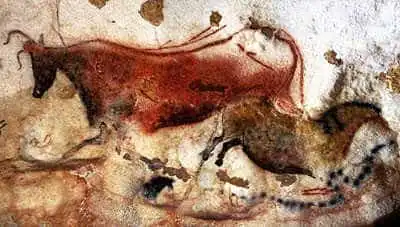FUNDAMENTALS |
BELIEFS A — Z |
|
INSPIRATION |
ENCYCLOPEDIA |
|
Change Cave painting from c. 15,000 BC. Lascaux in France. Life Energy FundamentalsHomo rudis, the ignorant man of our distant past, had no concern for societal effects when he speculated about life and death. He observed, he wondered, and he drew his conclusions independently of their consequences. He found no reason to do otherwise. Primeval mankind lived in flocks, like most primates. They supported themselves by gathering edibles from the vegetation, and by hunting. In such a society, there is little opportunity to collect riches or gain privileges. They ate what they caught, on a daily basis, and that was it. Hunting becomes more successful when done in an organized manner. This also allows for prey that are impossible to hunt on one's own. When hunting increased as a way to gather food, so did the cooperation of the individuals of the species. Still, society remained quite the same, and so did the day-to-day continuity. To this day, there are numerous societies of that kind, in many parts of our world. But the growing ability of organized efforts also enabled societies to commence with agriculture, which started to appear around 9500 BC, in the Middle East. This made room for surplus, and crops could be stored for a long time. In spite of that, human life expectancy was actually shortened drastically with the introduction of agriculture. Prior to it, people usually lived until their early thirties, but that dropped to twenty. This was probably due to the monotonous diet, and the oppressive societies that agriculture allowed for — not to mention large-scale warfare, which was also a novelty. War is neither common nor that lethal in hunter and gatherer societies, with very few exceptions. Only in the last couple of centuries, life expectancy has increased beyond what we had in Paleolithic times (from about 2.5 million years ago to c. 10,000 BC).
Next
About CookiesMy Other Websites
Qi Energy ExercisesThe ancient Chinese life energy qi (chi) explained and how to exercise it.
Creation MythsCreation stories from around the world, and the ancient cosmology they reveal.
Cosmos of the AncientsWhat the Greek philosophers believed about the cosmos, their religion and their gods.
TaoisticTaoism, the ancient Chinese philosophy of life explained. Also, the complete Tao Te Ching online.
Other Books of Mine
The Greek philosophers and what they thought about cosmology, myth, and the gods. Click the image to see the book at Amazon (paid link). |
 Life Energy Encyclopedia
Life Energy Encyclopedia Qi — Increase your life energy
Qi — Increase your life energy Cosmos of the Ancients
Cosmos of the Ancients Archetypes of Mythology
Archetypes of Mythology Tao Te Ching
Tao Te Ching Fake Lao Tzu Quotes
Fake Lao Tzu Quotes Stefan Stenudd
Stefan Stenudd